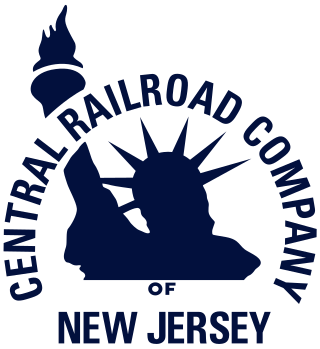The Lehigh Valley Railroad was a railroad built in the Northeastern United States to haul anthracite coal from the Coal Region in Pennsylvania. The railroad was authorized on April 21, 1846, for freight and transportation of passengers, goods, wares, merchandise and minerals in Pennsylvania and the railroad was incorporated and established on September 20, 1847, as the Delaware, Lehigh, Schuylkill and Susquehanna Railroad Company. On January 7, 1853, the railroad's name was changed to Lehigh Valley Railroad. It was sometimes known as the Route of the Black Diamond, named after the anthracite it transported. At the time, anthracite was transported by boat down the Lehigh River. The railroad ended operations in 1976 and merged into Conrail along with several northeastern railroads that same year.

The Reading Company was a Philadelphia-headquartered railroad that provided passenger and commercial rail transport in eastern Pennsylvania and neighboring states that operated from 1924 until its acquisition by Conrail in 1976.

The Central Railroad of New Jersey, also known as the New Jersey Central or Jersey Central Lines, was a Class I railroad with origins in the 1830s. It was absorbed into Conrail in April 1976 along with several other prominent bankrupt railroads of the Northeastern United States.
The Junction Railroad was a railroad created in 1860 to connect lines west of downtown Philadelphia, Pennsylvania, and allow north-south traffic through the metropolitan area for the first time. The railroad consisted of 3.56 miles of double track and 5.3 miles of sidings. It owned no locomotives or rolling stock. The line connected the Philadelphia and Reading Rail Road line at the west end of the Columbia Bridge over the Schuylkill River, crossed the Pennsylvania Railroad line, ran parallel to Market Street, and turned south to connect with the Philadelphia, Wilmington and Baltimore Railroad at Gray's Ferry.
The Lehigh & New England Railroad was a Class I railroad located in Northeastern United States that acted as a bridge line. It was the second notable U.S. railroad to file for abandonment in its entirety after New York, Ontario and Western Railway.
The North Pennsylvania Railroad was a railroad company which served Philadelphia, Montgomery County, Bucks County and Northampton County in Pennsylvania. It was formed in 1852, and began operation in 1855. The Philadelphia and Reading Railway, predecessor to the Reading Company, leased the North Pennsylvania in 1879. Its tracks were transferred to Conrail and the Southeastern Pennsylvania Transportation Authority (SEPTA) in 1976.
The Philadelphia and Erie Railroad was a railroad that operated in the U.S. state of Pennsylvania between 1861 and 1907. It was subsequently merged into the Pennsylvania Railroad (PRR).
The Allentown Railroad was a railway company in the United States. It was incorporated in 1853 with the original intention to connect the Central Railroad of New Jersey at Allentown with the Pennsylvania Railroad's main line across the Allegheny Mountains. Though grading was almost entirely finished, the project was halted by the Panic of 1857, and the completion of the East Pennsylvania Railroad in 1859 made the Allentown Railroad's proposed line largely redundant. As a result, track was never laid on most of the line. The small portion that did became the Allentown branch of the Reading Company from Topton to Kutztown, and was nominally owned by the Allentown Railroad until the Reading dissolved it in 1945 to simplify corporate bookkeeping. Other Reading subsidiaries also laid track on parts of the right-of-way elsewhere along the route. The short line Allentown & Auburn Railroad continues to operate freight service on the Topton to Kutztown route.

The Harrisburg Line is a rail line owned and operated by the Norfolk Southern Railway (NS) in the U.S. state of Pennsylvania. The line runs from Philadelphia west to Harrisburg.

The Lehigh Line is a railroad line in central New Jersey, Northeastern Pennsylvania, and the Lehigh Valley region of eastern Pennsylvania. It is owned and operated by the Norfolk Southern Railway. The line runs west from the vicinity of the Port of New York and New Jersey via Conrail's Lehigh Line to the Susquehanna River valley at the south end of the Wyoming Valley Coal Region. Administratively, it is part of Norfolk Southern's Keystone Division and is part of the Crescent Corridor. As of 2021 the line is freight-only, although there are perennial proposals to restore passenger service over all or part of the line.

The New York Branch or the Bound Brook Route was a railway line in Pennsylvania and New Jersey. It was operated by the Reading Company and owned by two of its subsidiaries, the North Pennsylvania Railroad and the Delaware and Bound Brook Railroad. It formed part of the Reading's route from Philadelphia to New York City, used by the famed Crusader. The line was transferred to Conrail in 1976 and was split into the Neshaminy Line and Trenton Line. SEPTA continues to operate commuter trains to West Trenton as part of its West Trenton Line.

The Ninth Street Branch was an elevated railway line in Philadelphia, Pennsylvania. It was operated by the Reading Company; ownership was split between the Reading and its subsidiary the Philadelphia, Germantown and Norristown Railroad. It was a four-tracked main line beginning at the Reading Terminal, the Reading's terminus in Philadelphia, and extending north into the city to a junction with the Bethlehem Branch. After the final bankruptcy of the Reading the line passed to Conrail and later SEPTA. The portion south of the Temple University station was abandoned in 1984 with the opening of the Center City Commuter Connection and is now known as the Reading Viaduct; the portion north is now part of the SEPTA Main Line.
The Lebanon Valley Branch was a railway line in Pennsylvania. Built between 1857–1858, it linked the cities of Harrisburg and Reading. It was part of the Reading Company system from its completion until 1976, when it was conveyed to Conrail. Under Conrail, the branch was merged with part of the former Reading Main Line to become the Harrisburg Line. It remains an important freight route.
The Main Line of the Reading Company was a railway line in the U.S. state of Pennsylvania. The 88-mile-long (142 km) main line ran from Philadelphia to Pottsville, Pennsylvania, following the Schuylkill River. Following the Reading's bankruptcy in the 1970s the line was conveyed to Conrail. The physical line continues to exist but is no longer administered as a single unit. Conrail split the line, combining the section from Philadelphia to Reading with the Lebanon Valley Branch to form the Harrisburg Line. The section north of Reading was designated the Pottsville Branch; Conrail later sold most of the branch to the Reading Blue Mountain and Northern Railroad.
The Wilmington and Northern Branch is a partially-abandoned railway line in the states of Delaware and Pennsylvania. It was constructed between 1869 and 1870 by the Wilmington and Reading Railroad, a predecessor of the Wilmington and Northern Railroad. At its fullest extent it connected Reading, Pennsylvania, with Wilmington, Delaware. The Philadelphia and Reading Railway leased the line in 1900. With the Reading Company's bankruptcy and the creation of Conrail in 1976 the line's ownership fragmented, and the section between Coatesville, Pennsylvania, and Birdsboro, Pennsylvania, has been abandoned.

The Warminster Branch is a railway line in the state of Pennsylvania. It runs 8.3 miles (13.4 km) from a junction with the SEPTA Main Line just north of Glenside to Warminster, where it meets the New Hope Railroad. It was originally built by the North East Pennsylvania Railroad, a subsidiary of the North Pennsylvania Railroad, between 1872 and 1874. It was part of the Reading Company system from 1879 until 1976. Today it is owned by SEPTA and hosts Warminster Line commuter rail service. A later extension of the branch to New Hope, Pennsylvania is now the New Hope Railroad heritage railway.
The Chestnut Hill East Branch is a railway line in Pennsylvania. It runs 5.5 miles (8.9 km) from a junction with the SEPTA Main Line in Nicetown–Tioga, a neighborhood in Philadelphia, to Chestnut Hill, Philadelphia. The oldest part of it was built in 1832 by the Philadelphia, Germantown and Norristown Railroad. It was part of the Reading Company system from 1870 until 1976. Today it is owned by SEPTA and hosts the Chestnut Hill East Line commuter rail service. The line runs roughly parallel to the Chestnut Hill West Branch, formerly of the Pennsylvania Railroad.
The Allentown branch, also known as the Kutztown branch or the Kutztown industrial track, is a railway line in Pennsylvania. It runs 4 miles (6.4 km) from a junction with the Reading Line at Topton to Kutztown. The line was built in 1870 by the Allentown Railroad and was part of the Reading Company system until 1976. The Kutztown Transportation Authority has owned the line since 2000. The Allentown and Auburn Railroad is the current operator.

The Colebrookdale branch, also known as the Colebrookdale spur, Colebrookdale industrial track or Colebrookdale line, is a railway line in Pennsylvania. It runs 8.6 miles (13.8 km) from a junction with the Harrisburg Line in Pottstown to Boyertown. At its fullest extent, the line continued another 4 miles (6.4 km) to Barto. The line was built between 1868–1869 by the Colebrookdale Railroad and part of the Reading Company system until 1976. Berks County has owned the line since 2009. The Eastern Berks Gateway Railroad operates freight service; heritage passenger services are run under the Colebrookdale Railroad name.
The Cornwall Railroad, formerly the North Lebanon Railroad, was a railway company in the state of Pennsylvania. It was incorporated in 1850 and opened its initial line between Lebanon and Cornwall, Pennsylvania, in 1855. The Reading Company bought the Cornwall Railroad in 1968. The line passed to Conrail on the Reading's bankruptcy in 1976 and has since been abandoned. The line ran parallel to that of the Cornwall and Lebanon Railroad, later part of the Pennsylvania Railroad system.









